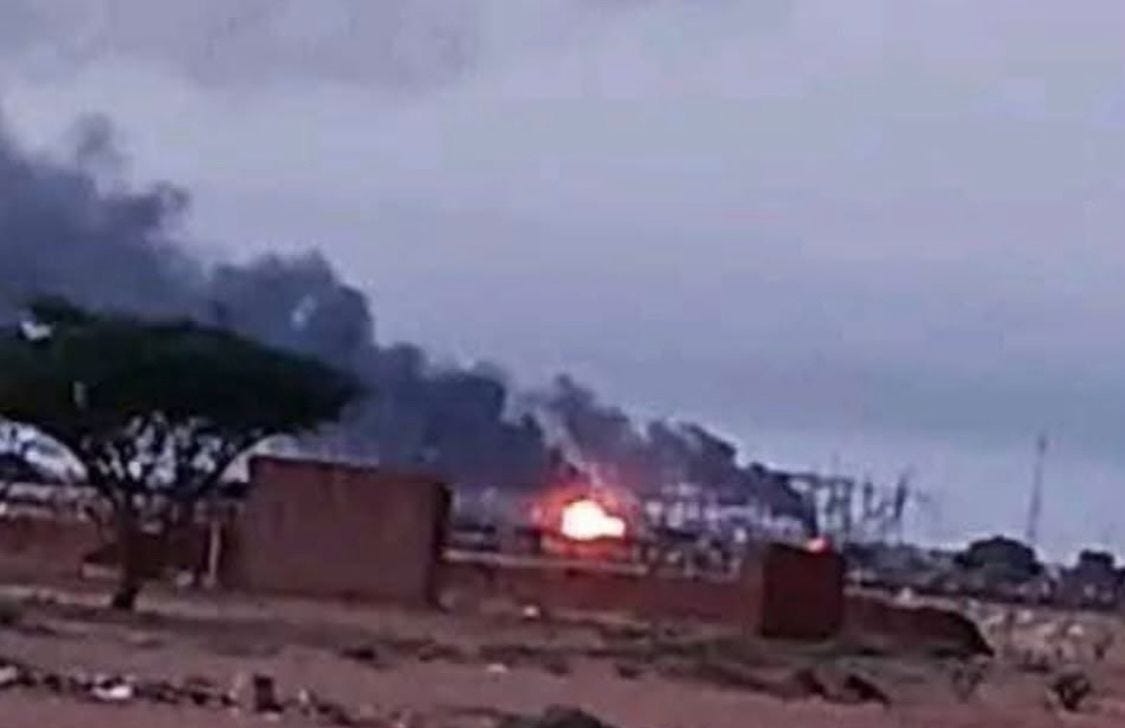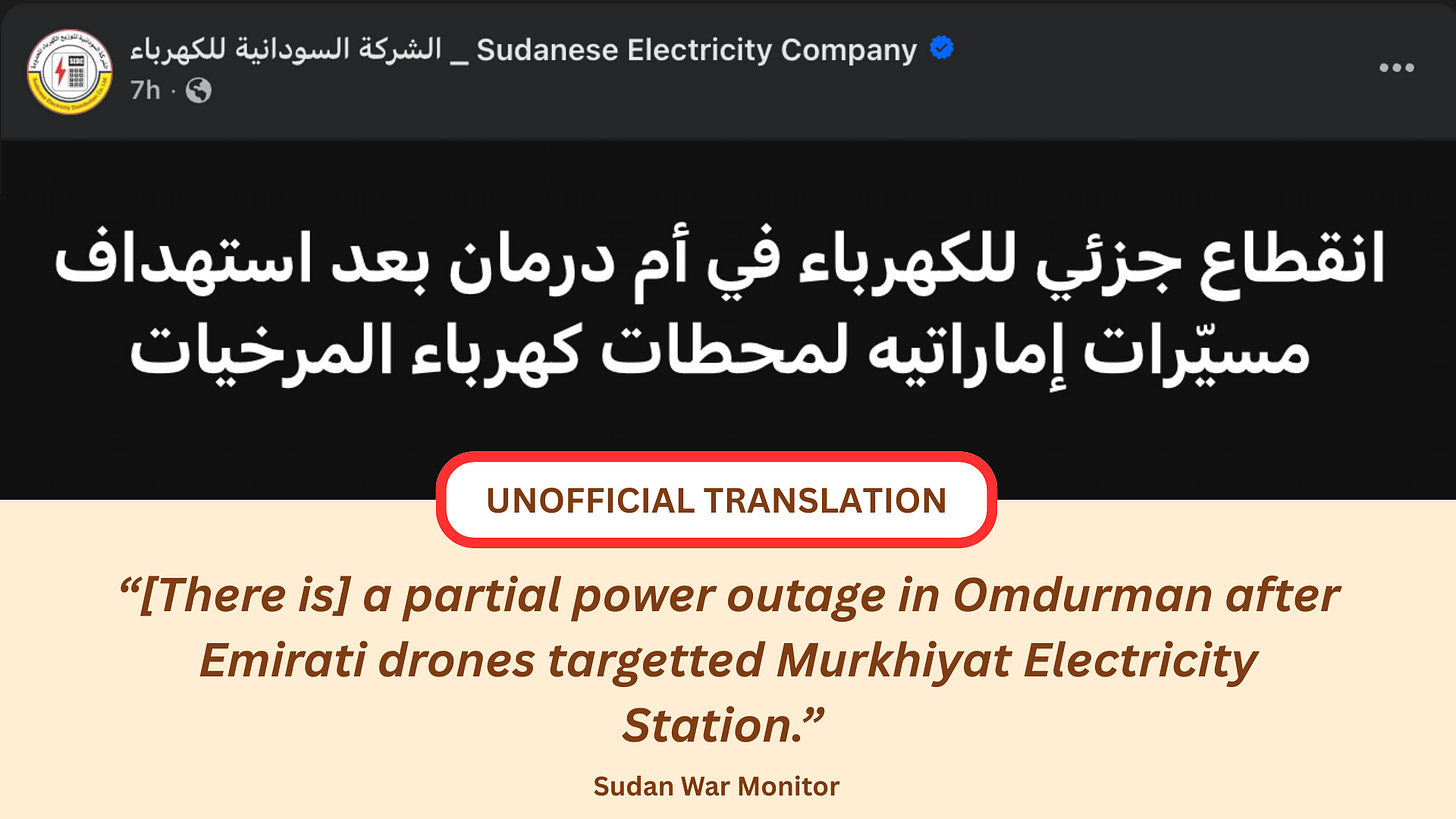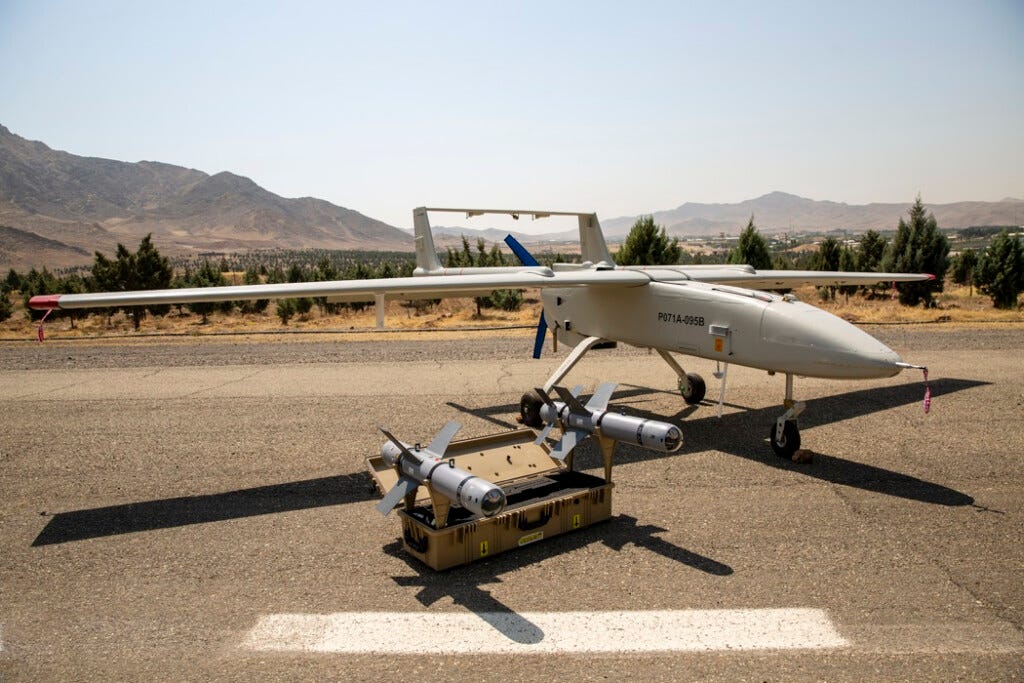Drone barrage targets Khartoum’s three cities
RSF intensifies drone attacks after losses in North Kordofan
A wave of drone strikes on Tuesday morning struck multiple sites across Khartoum, Sudan’s capital region, in one of the most significant escalations since the RSF’s expulsion from central Sudan earlier this year. The barrage targeted the Murkhiyat electricity transformer station in Omdurman, the Wadi Saedna military base, and additional locations in Khartoum and Bahri, leading to a major power outage across the capital’s largest city.
The Rapid Support Forces (RSF), Sudan’s dominant paramilitary force and the only actor with access to long-range armed drones after the Sudanese military, has carried out similar attacks in the past, though this incident marks the most extensive strike on the capital since May’s drone attack on Port Sudan, which has served as the country’s de facto capital since outbreak of the war in April 2023.
While the paramilitary group initially withheld acknowledgment, responsibility was later claimed by the Sudan Founding Alliance (Ta’sis), an RSF-led umbrella of allied factions established in February, framing the strikes as retaliation for Sudanese Armed Forces (SAF) bombardments of Nyala and other locations in Darfur.
The first confirmed target was the Murkhiyat Transformer Electricity Station in Omdurman’s western district of Ombada. Videos reviewed and geolocated by Sudan War Monitor show drones striking the facility in pre-dawn darkness, filmed by a resident east of the station. The geolocation of the footage places the attack at 15°46'54"N 32°19'26"E.
In the video below, an eyewitness captures moments of the targeting of the Murkhiyat power station.
Murkhiyat is not a power generator but a critical distribution hub within Khartoum’s fragile grid. It circulates high-voltage electricity across a 500 kV loop that includes Kabashi and the newly constructed Bager station, while also integrating imported energy from Ethiopia.
This is not the first time the station is targeted by both parties to the war, as SAF itself had targeted the infrastructure with fighter jets and shelling from Wadi Saedna at the start of the conflict. The station’s repeated targeting underscores its strategic importance and the latest attack triggered an immediate blackout across much of Omdurman, disrupting civilian life in the already war-battered city.
The Sudanese Electricity Company acknowledged the incident in a brief statement on Facebook, citing a “partial power outage in Omdurman” and attributing the drones to foreign backers. The company’s reference to “Emirati drones” reflects persistent SAF-aligned claims of external involvement in the RSF’s drone arsenal.
The second major target was near the Yarmouk military complex in Khartoum locality, a few kilometers from the downtown Khartoum. Though the exact facility struck has not been independently verified, geolocated footage shows an explosion in the vicinity, suggesting a deliberate attempt to disrupt SAF’s central military infrastructure.
Another strike targeted the elite military base, Wadi Saedna, which has hosted senior Sudanese military officials throughout the war and has an airfield that was used to withdraw foreign nationals at the start of the conflict. Unconfirmed reports alleges that two of a total five attacking sucicide drones were downed by SAF ground defenses near Wadi Saedna airbase.
A fourth strike was recorded in Jaili, north of Khartoum, where the capital’s oil refinery is located. While no visible damage has yet been confirmed, the targeting of such a facility highlights the RSF’s strategy of focusing on symbolic and infrastructure-heavy assets rather than battlefield positions.
Retaliation and threats of escalation
Later in the day, Alaa Al-Din Awad Naqd, spokesman for the Sudan Founding Alliance, issued a lengthy statement claiming the strikes as deliberate retaliation for SAF’s air campaign in Darfur. The group alleged the operations were “precise and successful,” portraying them as proportional responses to the SAF’s alleged targeting of hospitals and civilian infrastructure in Nyala and other towns.
The statement rejected responsibility for civilian harm, emphasizing that “operations targeted military and logistical sites” and reiterating the group’s commitment to fighting what it calls the “terrorist Islamic Movement Army and its militias.” It pledged further escalation against the “Port Sudan gang” – a reference to Sudan’s military and political leadership based in the Red Sea city – framing the RSF’s cause as a liberation struggle.
“The Sudan Founding Alliance announces that the precise and successful airstrikes carried out by its Air Force today, Tuesday, against military targets in Khartoum and other cities came as a direct response to the criminal targeting of hospitals and civilian facilities in Darfur and Kordofan, including the city of Nyala.”
“The Alliance affirms that these special operations targeted military and logistical sites that serve the enemy’s war effort, without harming civilians or their property, in steadfast commitment to our principles and ethics in confronting the crimes of the terrorist Islamic Movement Army and its militias, which wreak havoc and kill innocent people in Kordofan, Darfur, and other parts of Sudan.”
“The Alliance further confirms that all options remain open to respond to the repeated aggressions ordered by the “Port Sudan gang” and the terrorist organization of the Muslim Brotherhood, after they turned the army into an instrument of intimidation and repression against the people.”
“The Alliance renews its pledge to its people that its forces will strike with an iron fist anyone who dares to undermine the security and dignity of citizens, and will not retreat until it achieves its legitimate goals of destroying the dens of terrorism and completing the Founding Project to build a free homeland governed by true values of peace and justice,” the statement reads.
While the rhetoric is familiar, the scale and accuracy of the latest drone assault marks an intensification of RSF tactics, underscoring the growing centrality of UAVs in their campaign.
Escalating drone warfare
The RSF’s pivot to drones reflects both technological adaptation and battlefield necessity. Following heavy territorial losses in Khartoum and Al Jazira between January and April 2025, the paramilitary’s presence in central Sudan diminished sharply. Unable to sustain large ground offensives, the RSF has leaned on drones to extend its reach, bypassing SAF’s entrenched defenses and striking strategic assets far behind the frontlines.
Early in the war, RSF drone use was sporadic, limited largely to small suicide UAVs. By late-2024, however, their deployment expanded, culminating in symbolic attacks on the Merowe Dam and the Dongola electricity station, which caused nationwide power outages. May’s drone strike on Port Sudan marked a turning point, signaling RSF capability to project force across hundreds of kilometers.
For the RSF, drones now function as a substitute for conventional air power, an area where the SAF retains dominance. The psychological impact is significant, as drones buzzing over Khartoum evoke memories of the intense street battles that devastated the city in 2023 through early-2025, renewing civilian fears of renewed urban warfare.
The attacks are unlikely to decisively alter the military balance in Darfur or Kordofan, where SAF’s ongoing offensives have reclaimed towns such as Kazigil. Instead, they function as strategic disruptions, undermining SAF’s rear infrastructure and projecting the RSF’s continued relevance despite its territorial setbacks.
Another underlying aims of the RSF’s drone attacks on Khartoum appears to be the deliberate disruption of early reconstruction and humanitarian recovery efforts. Since the paramilitary group was pushed out of the capital in April, government ministries and aid agencies have begun tentative preparations to reestablish operations from the city, signaling the possibility of a slow but fragile return of displaced residents.
By striking infrastructure nodes such as the Murkhiyat transformer station, the RSF sends a clear warning that Khartoum is far from secure and that any attempt to normalize life in the capital remains vulnerable to sudden escalation.
The renewed targeting of Khartoum also reflects a strategic calculus to prevent the mass return of civilians, many of whom fled during the intense urban battles of 2023–2024. Families considering returning to rebuild homes or reopen businesses now face the uncertainty of renewed bombardments, while humanitarian organizations attempting to restore essential services confront new layers of risk.
For the RSF, sustaining this sense of insecurity not only undermines the government’s claim to control but also forestalls the symbolic and practical recovery of Khartoum as the country’s political and economic heart.
Support our journalism
Thank you for reading Sudan War Monitor. We do this work because we believe that journalism is one accountability mechanism that ultimately can contribute toward peace and justice in Sudan—however distant that hope may be. Our work is intended to be a resource for humanitarians, civil society, ordinary Sudanese, diplomats, and news media. Subscribe or share to support our work and help “Keep Eyes on Sudan.”






